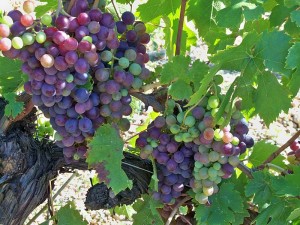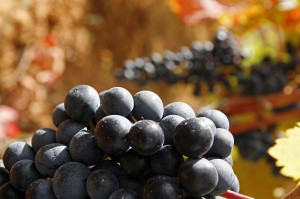The use of soil nitrogen fertilization has been frequently studied in grapes for its ability to alter wine aroma, however, the results of these studies have been quite variable. Some studies found that using organic and inorganic nitrogen fertilization improves wine aroma by increasing the concentrations of desirable aromatic volatile compounds, while many others found that this application damages wine aroma by increasing the levels of urea and ethyl carbamate, both of which are undesirable in wine.
One problem with using soil nitrogen fertilization is that the nitrate salts in the fertilizer are extremely soluble, thus increasing the risk of the salt leaching (i.e. leaking) into the soil and not contributing at all to fertilization or wine aroma.
Also, the more that this salt that leaks out into the soil, the greater the risk is of environmental harm and degradation.
In addition to soil fertilization, some vineyard managers opt to incorporate foliar fertilization (i.e. fertilization applied to the leaves), which functions as a more direct way to get nutrients to the vines instead of having much of it leach out into the soil unused. Since foliar fertilization results in the direct absorbance into the grapes themselves, much less of it needs to be applied than soil fertilizer.
With the knowledge that fertilization of grape vines affects wine aroma by increase the levels of certain desirable volatile compounds, one study aimed to examine the effects of foliar fertilization of urea (a nitrogen-based compound) on Tempranillo grape vines and how this fertilization altered the volatile chemistry of the finished wine. According to the authors, this type of study has never been done on Tempranillo vines.
Methods
Tempranillo vines (Vitis vinifera) from the 2008 vintage were used in this study. Experimental vines were split into three plots in the same vineyard which was located in the Rioja region of northern Spain. The vines were planted in 1990, and were about 9 ha total in vineyard size. Vine density was 2.7m x 1.5m, and the pruning regime used was the Gobelet method.
Soil pH was 8.3 and nitrogen fertilizer was applied to the entire vineyard at 21kg N/ha.
Two of the experimental plots were foliar urea fertilizer treatment plots, with one plot receiving 2kg N/ha and the other receiving 4kg N/ha. The third experimental plot was left untreated as a control.
Foliar fertilizer used was Nitrotecnia-20, 20% w/w of the total nitrogen in the fertilizer originating from urea.
Foliar urea fertilizer was applied at 7 day intervals between July 31st and October 9th, 2008. Treatment was started close to veraison (i.e. when the grapes start to change color) in order for the urea to be absorbed directly by the grape instead of most of it going into the leaves of the plant. As a side note for

By Véronique PAGNIER (Own work) [CC-BY-SA-3.0 (http://creativecommons.org/licenses/by-sa/3.0)], via Wikimedia Commons
At harvest, all grapes from all three plots were harvested, in order to create a homogenous must/wine from each plot. Grapes were de-stemmed, crushed, and pressed. The common wine yeast, Saccharomyces cerevisiae strain MV 92081 was used for the fermentation. Fermentation was held in stainless steel tanks and wine was fermented until dry. Wines were subsequently stabilized the filtered. Fermentation occurred in duplicate. Wine samples for analysis were chosen from different parts of the tank then blended, in order to create representative samples of the entire batch.
Odor activity values (OAV’s) were calculated for each volatile compound. Any OAV’s over a value of 1 meant that the flavor threshold has been reached meaning that the aroma of that compound can be detected in the wine.
In addition to measuring volatile compounds, amino acids, ammonium nitrogen, yeast assimilable nitrogen, and general enological parameters were measured.
For sensory analysis, 5 panelists (3 men and 2 women) were selected from 5 different wineries in Rioja. Panelist judged body, acidity, sweetness, bitterness, astringency, and tannin, as well as red fruits, plums, currants, chocolate, honey, vanilla, and green. Each characteristic was judged using a 5 point scale: 1 = very poor; 2 = poor; 3 = acceptable; 4 = good; and 5 = very good. Six sets of 3 wines were used for forced-choice tests.
Results
- Total acidity was higher in musts made from grapes treated with urea than musts made from control grapes.
- pH increased in the musts and wines of grapes treated with urea.
- Alcohol content (including higher alcohols) and total acidity decreased in wines made from grapes treated with urea compared with wines made from control grapes.
- Volatile acidity was below threshold for all wines.
- Amino nitrogen and YAN levels increased in wines made from grapes treated with urea.
- Isoamyl alcohol, isobutanol, 2-phenylethanol, tyrosol, tryptophol, and 3-methylthio-1-propanol all decreased in wines made from grapes treated with urea compared to wines made from control grapes.
- 1-hexanol and benzyl alcohol did not change due to treatment.
- 1-butanol increased in wines made from grapes treated with the higher dose of urea.
- OAV levels of isoamyl were greater than 1 in all three wines, thus corresponded to aroma.
- OAV levels of 2-phenylethanol were greater than 1 in control wines and the lower dose of urea wines. (This compound contributes to floral characteristics in wine).
- OAV levels of 2-phenylethanol were lower than 1 in the higher dose of urea wines, thus it did not contribute to the aroma of those wines.
- Precursor amino acids (with the exception of the precursor to tryptophan) all increased in wines made from grapes treated with urea compared with the control.
- Total esters decreased in wines made from grapes treated with urea.
- Ethyl hexanoate, ethyl octanoate, and ethyl decanoate all increased in wine made from grapes treated with the higher dose of urea.
- Ethyl hexanoate and ethyl octanoate OAV levels were greater than 1 for all wines, thus they both contributed to the aromatic profile of the wines, though the levels were significantly higher in the wines made from grapes treated with the higher dose of urea.
- Isoamyl acetate and ethyl acetate levels decreased in wines made from urea-treated grapes and contributed to wine aroma.
- Diethyl succinate, diethyl malate, and ethyl-3-hydroxybutyrate decreased in wines made from urea-treated grapes.
- 3-hydroxy-2-butanone and acevanillone increased in wines made from the grapes treated with the highest dose of urea.
- Foliar urea fertilization did not have much of an effect on fatty acids in wines.
- Butyric acids increased with grapes treated with the highest dose of urea.
- C10, C12, C14, C16, and C18 fatty acids (i.e. fatty acids with 10, 12, 14, 16, and 18 carbons) decreased in wines made from grapes treated with urea.
- Sensory Analysis:
- Body, acidity, sweetness, bitterness, and tannin were similar for all three wines.
- Wines treated with foliar urea fertilizer were lower in astringency than control wines.
- Fruity notes were higher in wines made from urea-treated grapes.
- Notes of chocolate, honey, and vanilla were the same for all three wines.
- Herbaceous notes were higher in control wines than wines made from urea-treated grapes.
- Wines made from urea-treated grapes were noted to have higher aromatic intensity, fruitier character, and bigger red fruit notes than control wines.
- Isoamyl alcohol and 2-phenylethanol are compounds than tend to cover up wine aroma, and it was found that wines made from urea-treated grapes were lower in these compounds than control wines.
Conclusions
The results of this study showed that there are significant differences in the aromatic profile of wines made from grapes that were treated with foliar urea fertilization. It is not known whether the panelists preferred one type of wine over another, just that the aromatic profiles were different. For Tempranillo wines made from grapes treated with foliar urea fertilization during the growing season, the aromatic profile shows increased fruity notes, as well as greater aromatic intensity. For control Tempranillo wines not treated with any foliar fertilizer, aromatic intensity was lower, and herbaceous notes were more pronounced.
It doesn’t appear that one wine was necessarily better than the other, but then again, there were no questions in the sensory analysis that addressed this question. Depending on what style of wine you enjoy, you may like either the

By María Jesús Tomé (Flickr: Rioja Alavesa) [CC-BY-2.0 (http://creativecommons.org/licenses/by/2.0)], via Wikimedia Commons
If you want to create a Tempranillo wine that is fruitier and more aromatic, it may be beneficial to employ a foliar urea fertilization regime in your vineyard management practices. It would be important to know how this fertilization treatment affects not only the grapevines and the resulting wine, but also the environment around it. This may be something to consider prior to employing such a practice.
It’s not clear how this type of treatment would affect other grape varieties; however, one would likely expect to see a varied outcome. Certainly, some grapes would have the ability to absorb more of the fertilizer than others, and some grapes would be able to utilize the excess nitrogen better than others. The effect of foliar urea fertilization is likely a case-by-case situation and it would be interesting to see in a follow up study how other grapes and resulting wines were affected by the treatment.
I’d love to hear what you think about this study. What other questions would you have liked to see answered that the authors did not discuss? Please leave your comments!
Source: Ancín-Azpilicueta, C., Nieto-Rojo, R., and Gómez-Cordón, J. 2012. Effect of foliar urea fertilization on volatile compounds in Tempranillo wines. Journal of the Science of Food and Agriculture. Released online prior to publication in print. DOI 10.1002/jsfa.5921.


5 comments for “Altering the Aromatic Profile of Tempranillo Wines Using Foliar Urea Fertilization”